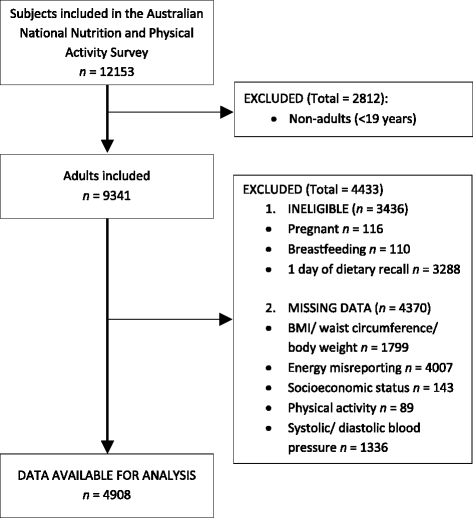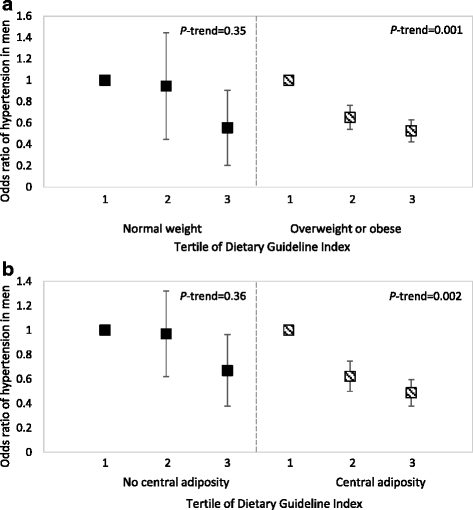Diet quality is associated with obesity and hypertension in Australian adults: a cross sectional study
- PMID: 27716133
- PMCID: PMC5045600
- DOI: 10.1186/s12889-016-3714-5
Diet quality is associated with obesity and hypertension in Australian adults: a cross sectional study
Abstract
Background: Poor diet, characterized by a low diet quality score, has been associated with greater prevelence of obesity and hypertension. However, the evidence is inconsistent across diet quality scores and by sex. The aim was to investigate the relationship between diet quality and obesity and hypertension.
Methods: Adults (n = 4908; age 45.2 ± 0.24 years) were included from the cross-sectional Australian Health Survey 2011-2013. Two 24-h dietary recalls were used to derive the dietary guideline index (DGI) and recommended food score (RFS). Logistic regression investigated relationships between diet quality score and odds ratio of obesity, hypertension and obesity-associated hypertension.
Results: In the highest tertile of DGI, but not RFS, individuals were less likely to be obese (men: OR 0.64, CI: 0.45, 0.92, P-trend = 0.014; women: 0.68, 0.48, 0.96, P-trend = 0.025) and to have central adiposity (men: 0.68, 0.48, 0.97, P-trend = 0.030; women: 0.53, 0.37, 0.77, P-trend = 0.001) compared with the lowest tertile. Men, but not women, in the highest tertile of DGI and RFS were less likely to be hypertensive (DGI: 0.56, 0.37, 0.85, P-trend = 0.006; RFS: 0.62, 0.41, 0.94, P-trend = 0.021) compared with the lowest tertile. In men with obesity, but not normal weight men or women, those in the highest tertile of DGI were less likely to be hypertensive (0.53, 0.36, 0.78, P-trend = 0.001) compared with the highest tertile.
Conclusions: Higher diet quality, as estimated using DGI, was associated with lower odds ratio of obesity in men and women. Odds ratio of hypertension was lower in men, but not women, with a high diet quality score compared with a low score, while obesity-associated hypertension was only associated with diet quality score in men with obesity. Longitudinal studies are needed to evaluate whether diet quality predicts risk of obesity and hypertension.
Keywords: Adults; Diet quality; Hypertension; Obesity; Obesity-related hypertension.
Figures


References
-
- World Health Organization. 21 December 2015. Internet: http://www.who.int/cardiovascular_diseases/publications/global_brief_hyp.... Accessed 12 Feb 2016.
-
- Appel LJ, Brands MW, Daniels SR, Karanja N, Elmer PJ, Sacks FM. Dietary approaches to prevent and treat hypertension: a scientific statement from the American Heart Association. Hypertension. 2006;47(2):296–308. http://dx.doi.org/10.1161/01.HYP.0000202568.01167.B6. - DOI - PubMed
-
- Guallar-Castillón P, Rodríguez-Artalejo F, Fornés NS, Banegas JR, Etxezarreta PA, Ardanaz E, Barricarte A, Chirlaque M-D, Iraeta MD, Larrañaga NL, et al. Intake of fried foods is associated with obesity in the cohort of Spanish adults from the European Prospective Investigation into Cancer and Nutrition. Am J Clin Nutr. 2007;86(1):198–205. - PubMed
-
- Wang H, Fox CS, Troy LM, Mckeown NM, Jacques PF. Longitudinal association of dairy consumption with the changes in blood pressure and the risk of incident hypertension: the Framingham Heart study. Br J Nutr. 2015;114(11):1887–99. http://dx.doi.org/10.1017/S0007114515003578. - DOI - PMC - PubMed
MeSH terms
LinkOut - more resources
Full Text Sources
Other Literature Sources
Medical

